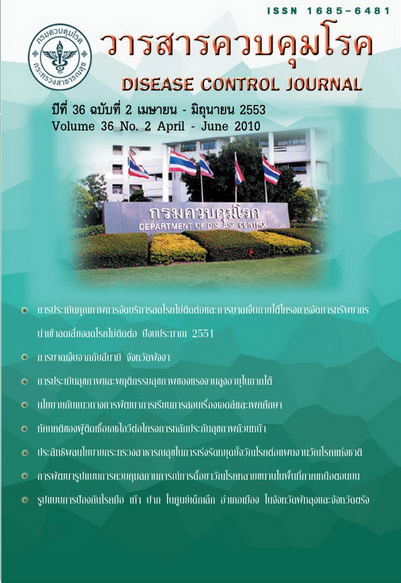Development of MDR-TB Control Model in Northern Thailand
Keywords:
MDR-TB control model, Northern ThailandAbstract
Thailand has implemented DOTS strategy to increase TB control program efficacy since 1997. However, Thailand couldn't achieve key TB control program indicators as indicated by the WHO. The MDRTB rate in northern Thailand has increased above hot spot level. The objective of this study was to compare new MDR-TB control program strategy to the conventional one in upper northern Thailand. We defined two MDR-TB control models. The first model had 3 steps. For step 1, all AFB positive sputum specimens from all hospitals located in 3 upper northern provinces (Chiang Mai, Lumpoon, and Phayao), were screened for Non Tuberculous Mycobacterium. For step 2, all MTB specimens were tested for drug sensitivity testing to identify MDR-TB cases with 1 month turn around time. For step 3, the patients would then be taking care with routine DOTS strategy. There were also 3 steps for the second model. The first two steps were the same as in model 1. But for the third steps, the patients would be communicated via mobile phone from the care giver to remind them about the medication time. In this third step, the MDR-TB patients were randomized to either be in model 1 or model 2. There were at least 19 patients in each arm. We followed the patients 18 months for measuring the treatment outcomes. It was found that the second model had significantly better sputum conversion rates when compared to the first model (p < 0.001). The conversion rates of model 2 were 84.2%, 89.5%, and 100% at month 1, 3, and 5 respectively. For model 1, the conversion rates were 57.9, 73.7, 84.2, and 94.7 at month 1, 2, 3,5 and 9 respectively. The treatment success rate of model 2 (100%) was also significantly higher than model 1 (73.7%) (p = 0.024). The MDR-TB rates in the region were decreased from 4.1% during April-September 2008, to 3.3% during October 2008-March 2009, and to 1.8% during April-September 2009. Successfulness of model 2 could be seen as an important strategy to decrease MDR-TB rate in 3 provinces of northern Thailand below hot spot level within 1 year. The DOT-PLUS strategies together with mobile phone communication as used in model 2 should be promoted in phase manner in order to improve TB control program efficacy. This could lead to achieve the Millennium Development Goals in 2015
Downloads
References
2. Global Tuberculosis Control: Surveillance, Planning, financing. WHO Report 2008. Geneva, World Health Organization
3. เอกสารการดำเนินงานป้องกันควบคุมวัณโรค โดยสำนักงานบริหารโครงการกองทุนโลกด้านวัณโรค
4. http://203.157.19.193/aids/aidatab8.html.
5. เอกสารรายงานการกำกับติดตามประเมินผลงานวัณโรคระดับชาติ ปีงบประมาณ 2544-2548 . รายงานการขึ้นทะเบียนรักษาวัณโรค ประจำปี 2548 (1 ตุลาคม 2547- 30 กันยายน 2548)
6. Kunawararak P, Chanwong S, Pokeaw P, Siri S, Prapanwong A, Lergngarm S, The situation of nontuberculous mycobacterium (NTM) in UpperNorth of Thailand. Abstract : 9th International conference on AIDS in Asia and the Pacific, Bali, Indonesia 9-13 August 2009.
7. Yoshiyama T, Supawitkul S, Kunyanone N, et al. Prevalence of drug-resistance tuberculosis in an area with human immunodeficiency virus epidemics in northern Thailand. Int J Tuberc Lung Dis. 2001; 5: 32-39
8. Yoshiyama T, Yanai H, Rhiengtong D, Palittapong arnpim P, Nampaisan O, Supawitkul S, Uthaivorawit W, Mori T. Development of acquired drug resistance in recurrent tuberculosis patients with various previous treatment outcomes. Int J Tuberc Lung Dis. 2004; 8(1): 31-37
9. Tubercolosis Control in the South-East Asia Region: Advocacy and planning, WHO Support to TB Control in Region. The Regionnal Report: New Delhi, WHO : 2006
10. เอกสารสรุปรายงานการประเมินผลการดำเนินงานควบคุมวัณโรค ของ Team องค์การอนามัยโลกในประเทศไทย เดือนกันยายน 2550
11 สุรสิงห์ วิศรุตรัตน์ และคณะฯ . การใช้ Mobile phone เพื่อช่วยการดูแลรักษาผู้ป่วยวัณโรค : สรุปรายงานเบื้องต้น. หนังสือพิมพ์ The Nation : Bangkok, 28 มกราคม 2550
12. Treatment of drug-resistance tuberculosis in special condition and situation . Guidelines for the programmatic management of drug-resistance tuberculosis, Geneva, WHO. 2006
13. ทัศนีย์ นุชประยูร, เติมศรี ชำนิจารกิจ. การวิจัยชุมชนทางการแพทย์. กรุงเทพฯ: โรงพิมพ์จุฬาลงกรณ์มหาวิทยาลัย; พิมพ์ครั้งที่ 2 :2533
14. Boom R, Soi CIA, Salimans MMM, et al. Rapid and simple method for purification of nucleic acids. J Clin Microbiol; 1990; 28: 495-503
15. Van Der Vliet G, Schukkink R,van Gemen B, et al. Nucleic acid sequence-based amplification (NASBA) for the identification of mycobacterie J General Microbiol. 1993; 139: 2423-2429.
16. Tyagi,S. and Kramer,F.R. Molecular beacons: Probes that fluoresce upon hybridaization. Nature Biotechnol. 1996; 14: 303-308
17. สำนักวัณโรค กรมควบคุมโรค กระทรวงสาธารณสุข. แนวทางแห่งชาติสำหรับการรักษาวัณโรคดื้อยาหลาย ขนาน (MDR-TB). 2551: 1-30.
18. http://203.157.45.99/epinorth/tb/tb.pdf
19. Tuberculosis Research Center Chennai; India. Low rate of Emergence of drug resistance in sputum positive patients treated with short course chemotherapy. International Journal of Tuberculosis and Lung Disease. 2001; 5(1): 40-45
20. Nathanson E, Lambregts-van Weezenbeek C, Rich ML,Gupta R,Bayona J, et al. Multidrugresistant tuberculosis management in resourcelimited settings. Emerg Infect Dis. 2006; 12: 1389-1397.
21. Tupasl TE, Gupta R, Quelapio MID, Orillaza RB, Mira NR, et al. Feasibility and cost-effectiveness of treating multidrug-resistant tuberculosis: A cohort study in the Philippines. Plos Med 3:e352.doi:10.1371/journal.pmed. 0030352
22. World Health Organization. The feasibility and efficiency of controlling MDR -TB using the DOTS-Plus strategy in the Russian Federation. WHO/HTM/TB/2005.357c. Available: http://whqlibdoc.who.int/hq/2005/WHO_HTM_TB_ 2005.357_3_eng.pdf.Accessed 2 october 2007.
Downloads
Published
How to Cite
Issue
Section
License
Articles published in the Disease Control Journal are considered as academic work, research or analysis of the personal opinion of the authors, not the opinion of the Thailand Department of Disease Control or editorial team. The authors must be responsible for their articles.


.png)



